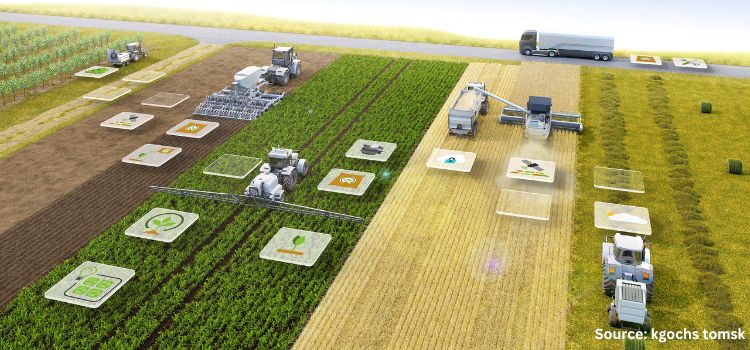Harvesting Change: Evolution of Agrochemical Strategies in Modern Agriculture
17-Feb-2025

Introduction
The global challenge of feeding an estimated 9.8 billion people by 2050 has put immense pressure on farmers to increase productivity by 50%. Amidst this, addressing climate change and protecting finite natural resources have become paramount challenges. As the agricultural sector undergoes a dynamic evolution in pursuit of these critical goals, the agrochemicals industry stands as a linchpin, with innovations in crop protection assuming a pivotal role.
Regulatory Constraints and Industry Dynamics
Meeting the rules and regulations for creating and delivering essential agrochemical products has become quite a challenge for businesses. The heightened scrutiny of environmental impacts has compelled industry leaders, such as Ramnath Subramanian, Vice President of Crop Protection R&D at Corteva Agriscience, to advocate for a regulatory process aligned with social acceptance, parallel to the pharmaceutical industry. This perspective recognizes the need for a more streamlined approach that facilitates the swift deployment of science-based solutions tailored to meet the evolving needs of farmers.
Evolving Product Landscape
The evolution of agrochemical products captures the industry's unwavering commitment to research and development. Phillips McDougall's study highlights a shift from 15 chemical groups in the 1960s to over 40 today, illustrating a dynamic response to challenges, such as resistance to insecticides, fungicides, and herbicides. Despite the prolonged regulatory timelines, the consistent investment of major companies, ranging from 7% to 10% of their annual sales over the last 50 years, has been instrumental in meeting regulatory study requirements and significantly improving the efficacy & safety profiles of new products.
Addressing Environmental Concerns
The adaptation to heightened regulatory procedures has resulted in a positive outcome—reduced application rates. Syngenta's approach is a compelling example, attributing the drastic reduction of approximately 95% of agricultural inputs to the accelerated adoption of new technologies. Precision application, satellite and drone imaging, internet-of-things sensors, and digital prescriptions have ushered in a new era where crop protection products are designed with selectivity, minimal environmental footprint, and undetectable residues in mind. Products such as Adepidyn, Plinazolin, and Tymirium from Syngenta illustrate this shift, offering longer-lasting control, fewer applications, and protection against a broad spectrum of plant-parasitic nematodes.
Innovation as a Response to Challenges
Challenges posed by regulatory constraints have led to transformative innovations within the agrochemical industry. Companies such as BASF and Bayer are not merely adapting, they are redefining their research and development methodologies. BASF's Sustainable Solutions Steering method, exemplified by their investment of approximately USD 964.8 million in R&D in 2021, encompasses seeds and traits, biological and chemical crop protection, and digital solutions.
Bayer, with an annual R&D investment of USD 2.144 billion, is advancing products such as SmartStax PRO with RNAi technology, Fox Supra soybean fungicide, and ThryvOn biotechnology traits, signaling a commitment to adopting innovation with the practical needs of farmers.
Biologicals and Soil Health
The decline in conventional agrochemical products has ushered in a new era of biological alternatives. Corteva's focus on natural pesticide options, including biopesticides and molecular-based pesticides, aligns with the industry's shift toward 'green' delivery systems. The surge in biological products, with an annual introduction of around 11 new biologicals, is a testament to the industry's responsiveness to the growing demand for diverse and sustainable solutions. Moreover, there is a significant emphasis on soil health, as seen in Syngenta's pipeline, which aims to broaden its focus from pest, weed, and disease control to include holistic plant and soil health.
The Role of Technology
In this transformation, technology plays a crucial role. Companies leverage cutting-edge tools such as precision agriculture, satellite imaging, and data analytics to optimize crop protection strategies. For instance, BASF is collaborating with Bosch to develop smart spraying solutions that integrate agronomic intelligence with high-tech camera sensor technology for real-time & automated weed identification and precision management. Bayer's FieldView digital farming platform is another example, measuring on-field carbon capture and enabling growers to track their progress.
Bayer is teaming up with Microsoft to develop fresh tools and solutions using data science. They are also working on Project Carbonview, a technology solution for growers. This project aims to help ethanol producers by allowing them to report, analyze, and better understand the impact of environmental throughout their entire supply chain.
Environmental Impact Reduction
Amidst growing environmental concerns, the industry is actively working toward reducing its carbon footprint. Bayer's Smart Corn System, set to launch across select geographies, exemplifies this approach by combining new corn technologies with digital solutions, data-driven decision-making, and potentially new business strategies. The focus on minimizing greenhouse gas emissions and keeping carbon in the ground reflects a broader commitment to environmental responsibility.
Global Collaboration for Sustainable Agriculture:
The path to a sustainable future in agriculture requires global collaboration. Companies such as BASF, Bayer, Syngenta, and Corteva are not only innovating individually but also engaging in collaborative efforts. For instance, BASF is developing new mixtures, combining Revysol- and Xemium-based solutions, to control soybean diseases effectively.
In another notable instance, BASF collaborates with Bosch in the co-development of smart spraying solutions, aiming to enhance weed control. The joint effort integrates the agricultural insights from BASF's xarvio Digital Farming Solutions with Bosch's advanced camera sensor technology and software.
According to Huff, Senior Vice President at BASF Agricultural Solutions, the collaborative technology aims to provide real-time, automated identification of weeds pre- and post-emergence, facilitating precise management. Anticipating a significant impact, BASF plans to launch the smart spraying solution in Brazil, North America, and Europe within 2023. The emphasis on collaborative solutions and individual endeavors showcases a collective commitment to addressing the multifaceted challenges facing agriculture.
Conclusion
The agrochemicals industry is not merely adapting to challenges; it is leveraging innovation in crop protection to pave the way for a sustainable future. Rather than impeding progress, regulatory constraints have become drivers for transformative change. As the industry grapples with an evolving landscape, the narratives of BASF, Bayer, Syngenta, and Corteva underscore the integral role played by collaboration, harmonized regulations, and sustained investment in steering the global agriculture toward a resilient and sustainable future. The story of crop protection is evolving—it is a narrative of commitment to environmental stewardship, responsible agriculture, and a future where innovation and sustainability go hand in hand.
About the Author
 Sunanda Ghosh is a researcher with more than 3 years of experience. She has a passion for understanding consumer behavior and market trends, and uses her skills in innovative ways to gather and analyze data. Throughout her career, she has worked with a diverse range of global clients across various industries including technology, semiconductor, and energy. She is dedicated to providing valuable insights that can help shape a company's direction and drive success.
Sunanda Ghosh is a researcher with more than 3 years of experience. She has a passion for understanding consumer behavior and market trends, and uses her skills in innovative ways to gather and analyze data. Throughout her career, she has worked with a diverse range of global clients across various industries including technology, semiconductor, and energy. She is dedicated to providing valuable insights that can help shape a company's direction and drive success.
The author can be reached at info@nextmsc.com







